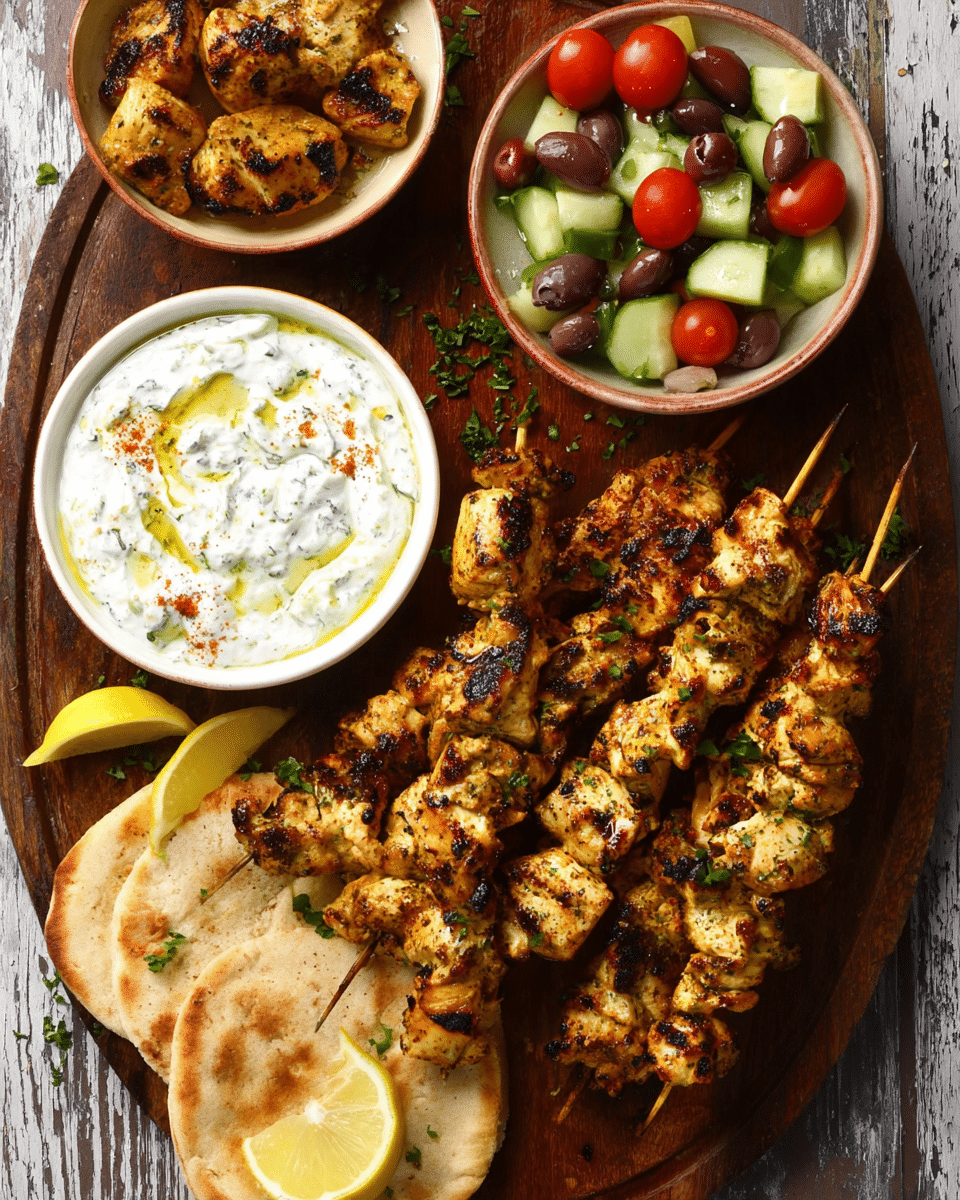The beauty of Greek Chicken Souvlaki lies in its simplicity—tender chunks of chicken soaked in a zesty lemon-garlic-oregano marinade, then grilled or roasted to juicy perfection. This dish captures the bold, bright flavors of the Mediterranean and brings them right into your kitchen with minimal effort.
Perfect for a summer barbecue, a laid-back dinner, or even meal prep for the week, this recipe is incredibly versatile. Serve it in warm pita with tzatziki, toss it on a salad, or plate it over rice with grilled vegetables. However you serve it, this souvlaki will transport your taste buds straight to a seaside taverna in Greece.
Full Recipe:
-
2 lbs boneless, skinless chicken (breast, tenderloin, or thigh)
-
¼ cup extra virgin olive oil
-
Juice of 1 large lemon
-
6 garlic cloves, minced
-
1½ Tbsp dried oregano
-
1 tsp salt
-
½ tsp freshly ground black pepper
-
2 Tbsp olive oil (for stovetop cooking, optional)
-
Skewers (metal or wooden soaked in water for 30 minutes)
Directions:
-
Cut the chicken into bite-sized pieces and place in a large zip-top bag.
-
In a small bowl, whisk together olive oil, lemon juice, garlic, oregano, salt, and pepper. Pour the marinade over the chicken.
-
Seal the bag tightly, removing excess air. Massage the marinade into the chicken with your hands. Refrigerate for at least 2-3 hours, ideally overnight.
-
Thread the marinated chicken onto skewers.
-
Choose your cooking method:
-
Grill Method: Preheat grill to medium-high heat. Grill skewers for 8-10 minutes, turning halfway through.
-
Oven Method: Preheat oven to 450°F (232°C). Place skewers on a wire rack set over a baking sheet. Bake for 15 minutes, then broil for 2-3 minutes to char.
-
Stovetop Method: Heat 2 Tbsp olive oil in a skillet over medium-high heat. Cook skewers for 6-8 minutes per side.
-
-
Let chicken rest for 3 minutes before serving. Serve with pita, tzatziki, or salad.
Prep Time: 15 minutes | Cooking Time: 15 minutes | Total Time: 30 minutes (+ marination)
Kcal: 253 kcal per skewer | Servings: 10 skewers
Recipe Overview
Greek Chicken Souvlaki is one of those rare dishes that strikes the perfect balance between simple ingredients and bold flavor. It’s a go-to favorite for busy weeknights, weekend barbecues, or even meal prep Sundays. At its core, it’s just marinated chicken skewered and grilled, but when those Mediterranean flavors come together—lemon, garlic, oregano, olive oil—it becomes something magical. The end result is juicy, aromatic chicken with just the right amount of char, making it a staple in Greek cuisine and a beloved dish around the world.
Whether you’re serving it wrapped in a warm pita with creamy tzatziki or plating it over a bed of fresh salad greens, Souvlaki is one of those meals that always satisfies. And the best part? It’s adaptable, nutritious, and incredibly easy to prepare.
History and Origin
The word Souvlaki comes from the Greek word souvla, meaning “skewer.” While today we associate souvlaki with chicken or pork grilled on skewers, the concept of skewered meat dates back to ancient times. In fact, archaeologists have uncovered stone grilling supports in Santorini that date back to the 17th century BC—yes, even the ancient Greeks loved a good barbecue.
In modern Greece, souvlaki is as ubiquitous as burgers are in the U.S. You’ll find it served everywhere from street food stalls to upscale restaurants. Traditionally, it’s made with pork or lamb, but chicken has become a widely loved alternative, especially for those seeking a lighter protein.
Souvlaki holds cultural significance far beyond its ingredients. It’s the type of food that brings people together. Picture a warm evening in Athens, friends gathered around a small table, skewers sizzling on the grill, cold beers in hand. It’s a dish woven into the social and culinary fabric of Greece.
Variations and Adaptations
While the basic idea remains the same—marinated meat grilled on skewers—Souvlaki has evolved in numerous ways depending on regional preferences and dietary needs.
Meat Options: In Greece, pork is the most traditional, but chicken, lamb, and even beef are commonly used. Outside Greece, turkey and tofu are popular alternatives for those seeking leaner or vegetarian-friendly options.
Marinade Tweaks: The core marinade usually includes olive oil, lemon juice, garlic, and oregano. Some versions add yogurt for extra tenderness, while others include spices like paprika, cumin, or coriander for a flavor twist.
Serving Styles: In northern Greece, you’re more likely to find souvlaki served with mustard sauce, while in the islands, it’s often paired with fresh seafood dishes. It’s also served in wraps with fries tucked inside, a common Greek fast-food touch.
Vegetarian Adaptations: Veggie souvlaki is a thing! Think grilled zucchini, mushrooms, red onions, and bell peppers marinated in the same herby lemon-olive oil mixture and grilled until tender.
In essence, Souvlaki is the kind of dish that welcomes creativity without compromising tradition.
Nutritional Information
Greek Chicken Souvlaki isn’t just delicious—it’s also a great choice nutritionally, especially for those on a Mediterranean or low-carb diet.
-
Calories: One chicken souvlaki skewer contains around 250-300 calories, depending on the size and amount of oil used.
-
Protein: High in protein, each skewer delivers approximately 22–25 grams, making it excellent for muscle maintenance and satiety.
-
Fat: Thanks to the olive oil, it contains healthy monounsaturated fats (~15–17 grams per skewer). These fats support heart health and inflammation reduction.
-
Carbohydrates: Virtually zero, unless served in a pita or with rice.
-
Micronutrients:
-
Vitamin B6 & Niacin from the chicken, essential for energy metabolism and brain health.
-
Vitamin C from the lemon juice, which also aids in iron absorption.
-
Iron & Zinc, both of which boost immune function and support oxygen transport.
-
Overall, this is a nutrient-dense meal packed with lean protein, heart-healthy fats, and immune-supporting vitamins.
Serving Suggestions and Pairings
One of the most enjoyable parts of making Greek Chicken Souvlaki is serving it. It’s such a versatile dish that you can adapt it to suit any mood or occasion.
-
Classic Style: Wrap the chicken in a warm pita with fresh tomatoes, onions, lettuce, and a generous dollop of tzatziki.
-
Plated Meal: Serve over a bed of Greek lemon rice or herbed couscous, with a side of grilled vegetables and feta cheese.
-
Low-Carb Option: Place the skewers on a large Greek salad with cucumbers, olives, cherry tomatoes, red onion, and a simple vinaigrette.
-
Entertaining: Create a Mezze platter with hummus, dolmas, grilled eggplant, and warm pita bread.
-
Drink Pairings:
-
White Wine: Assyrtiko or Sauvignon Blanc work beautifully with the lemony profile.
-
Beer: A crisp lager or light pilsner enhances the smoky, grilled flavors.
-
Non-Alcoholic: Sparkling water with cucumber and mint or a light lemonade.
-
This dish transitions effortlessly from a casual weeknight meal to an elegant weekend spread.
Tips and Tricks for Success
Cooking Souvlaki at home is relatively straightforward, but here are a few expert-level tips to help you make it truly exceptional:
-
Marinate Longer: While 2-3 hours will work, overnight marinating allows the flavors to fully penetrate the meat and enhances tenderness.
-
Equal Sizing: Cut your chicken pieces into uniform sizes for even cooking and a better bite.
-
Soak Wooden Skewers: If using wooden skewers, soak them in water for at least 30 minutes to prevent burning.
-
Let it Rest: Once cooked, allow the skewers to rest for 3-5 minutes to retain their juices.
-
Add Yogurt (Optional): Adding a tablespoon or two of Greek yogurt to the marinade can help tenderize the chicken even further.
-
Broil to Finish: Want that charred look without a grill? Use the broiler for the last 2-3 minutes of oven cooking to mimic that effect.
Potential Health Benefits
Greek Chicken Souvlaki isn’t just a tasty option—it aligns perfectly with the Mediterranean diet, one of the most studied and recommended diets globally.
Advertisement
-
Heart Health: Olive oil and lean chicken together make this a heart-smart dish. The monounsaturated fats in olive oil help lower LDL cholesterol.
-
Weight Management: High protein, low carb, and low sugar—this combination helps with blood sugar control and keeps you feeling full longer.
-
Anti-inflammatory: Garlic and oregano are not only flavorful but also offer anti-inflammatory and antimicrobial properties.
-
Digestive Health: When paired with yogurt-based tzatziki, you’re also adding probiotics that support gut health.
Plus, its clean ingredient list makes it suitable for people with dietary restrictions like gluten sensitivity or low-carb needs.
Conclusion
Greek Chicken Souvlaki is the kind of dish that proves simple ingredients can lead to spectacular meals. It’s rich in history, brimming with flavor, and endlessly customizable to suit your taste or dietary preferences. Whether you’re grilling outdoors on a summer day or baking indoors in the winter, this dish offers a taste of Greece that anyone can enjoy.
With its perfect balance of zesty lemon, bold garlic, and savory herbs, it’s no wonder souvlaki remains a beloved staple in Greek homes and street corners alike. Give it a try—you might just find it becomes one of your favorite go-to meals too.






